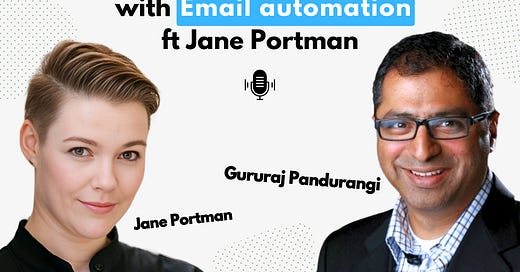Today, we're exploring email automation's role in customer journeys with Jane Portman, co-founder of Userlist.
Jane, also the host of UI Breakfast and Better Done Than Perfect, shared her expertise on using email automation to boost onboarding, engagement, and nurturing. Whether you're a startup or an established business, this episode is packed with actionable insights.
Listen now on Apple, Spotify, Castbox, Google and YouTube.
Jane's Journey and Userlist's Evolution
Early Ventures: Jane’s past startup experiences laid the foundation for Userlist, which she co-founded in 2017.
Product Evolution: Userlist was launched as a customer messaging platform in 2019. It pivoted into a comprehensive email marketing tool based on user demand for better onboarding, engagement, and nurturing solutions.
Key Insights
Listen to Customers: The evolution of Userlist was driven by user feedback and the need to address broader market demands.
Adaptability: Success often requires pivoting your product to better align with customer needs.
Community Support: The Product Hunt launch was crucial in validating the product and building a loyal user base.
Understanding Email Automation for Customer Journeys
1. The Role of Email Automation
Definition: Email automation streamlines customer communication, ensuring timely and relevant interactions.
Purpose: Enhances customer onboarding, engagement, and nurturing by automating key touchpoints throughout the customer lifecycle.
2. Types of Emails
Marketing Emails: Focus on promotional content and campaigns aimed at acquiring new customers.
Transactional Emails: Triggered by customer actions (e.g., purchase confirmations) and crucial for delivering essential information.
Customer Lifecycle Emails: Designed to support users through various stages, from onboarding to retention.
3. Drip vs. Nurture Campaigns
Drip Campaigns: A series of automated emails sent on a schedule to educate or inform the user.
Nurture Campaigns: Tailored email series aimed at guiding users through specific journeys, such as onboarding or re-engagement, based on their behavior and needs.
Key Takeaways
Automation Efficiency: Email automation reduces manual effort, allowing businesses to focus on strategy rather than execution.
Personalization: Effective automation requires personalized content to resonate with users at different stages of their journey.
Impact: When done right, email automation can significantly reduce dropouts and increase customer engagement.
Essential Information in Emails
Start with Clarity:
Emails should begin with a clear and relevant message that speaks directly to the user's current needs or actions. Avoid jargon and focus on what matters to the user right now.
Guide with Action:
Include specific, actionable steps that guide the user towards the next phase of their journey. Whether it’s a link, a prompt to explore a feature, or a purchase, make it obvious and easy to follow.
Design for Impact:
Structure your emails with concise messaging and strategic use of visuals. Keep the text short and impactful, and use images or infographics sparingly to support your message without clutter.
Personalize and Customize:
Segment your audience to tailor content based on behavior and preferences. Use dynamic content to personalize each email, making it feel like a one-on-one conversation rather than a mass message.
Call to Action:
Conclude with a strong, clear CTA that encourages the desired response, be it clicking a link, replying to the email, or making a decision.
By following these steps, your emails will not only engage but also retain customers, ensuring they remain connected and active within your product.
Insights for Early-Stage Companies
"For early-stage companies, the key is to stay focused on solving a specific problem exceptionally well, rather than trying to be everything to everyone."
Focus on Your Core:
Early-stage companies should prioritize perfecting their primary product or service. This focus ensures they solve a specific problem exceptionally well, creating a strong foundation for growth.
Lean and Adaptable:
Startups thrive by being agile. Adapting quickly to user feedback allows for continuous improvement and keeps the product aligned with market needs.
Build Strong Relationships:
Early relationships with users are crucial. Engaging closely with your initial customers not only helps refine the product but also builds a loyal user base that can advocate for your brand.
Actionable Advice:
Stay Focused: Resist the urge to expand too quickly; concentrate on doing one thing better than anyone else.
Listen and Learn: Use customer feedback as a tool for continuous product improvement.
Invest in Relationships: Foster early connections with users to build a community that supports and grows with your brand.
Key Timestamps
(00:00) Introduction to the episode and guest, Jane Portman
(02:30) The importance of staying focused for early-stage companies
(08:15) The role of customer segmentation in email marketing
(14:20) Key strategies for building customer relationships
(20:05) How to use email automation effectively
(25:45) Insights on drip vs. nurture campaigns
(30:10) The essential elements of a powerful email
(35:25) Jane's advice on maintaining agility in startups
(38:15) Concluding thoughts and actionable advice for early-stage companies
(39:50) Closing remarks
Links mentioned in the podcast
https://userlist.com/blog/marketing-lifecycle-transactional-email/
The overarching guide on SaaS email: https://userlist.com/blog/saas-email-marketing-strategies/
Where to Find the Guest:
LinkedIn: Jane Portman
Where to Find the Host:
LinkedIn: Gururaj Pandurangi














Share this post